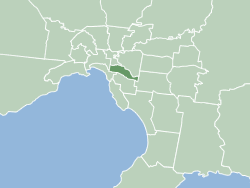
The City of Stonnington is a local government area located within the metropolitan area of Melbourne, Australia. It comprises the inner south-eastern suburbs, between 3 and 13 km, from the Melbourne CBD. The city covers an area of 25.7 km2 (9.9 sq mi).

Kooyong is a suburb in Melbourne, Victoria, Australia, 7 km south-east of Melbourne's Central Business District, located within the City of Stonnington local government area. Kooyong recorded a population of 842 at the 2021 census.

Malvern ( ) is a suburb of Melbourne, Victoria, Australia, 8 km south-east of Melbourne's Central Business District, located within the City of Stonnington local government area. Malvern recorded a population of 9,929 at the 2021 census.

South Yarra is an inner-city suburb in Melbourne, Victoria, Australia, 4 km south-east of Melbourne's Central Business District, located within the Cities of Melbourne and Stonnington local government areas. South Yarra recorded a population of 25,028 at the 2021 census.

Toorak is a suburb of Melbourne, Victoria, Australia, 5 km (3.1 mi) south-east of Melbourne's Central Business District, located within the City of Stonnington local government area. Toorak recorded a population of 12,817 at the 2021 census.
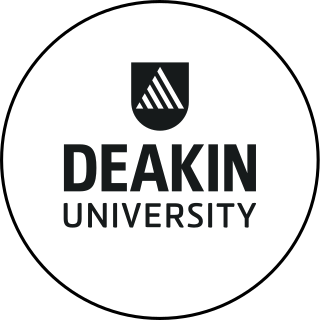
Deakin University is a public university in Victoria, Australia. Founded in 1974, the university was named after Alfred Deakin, the second Prime Minister of Australia.

Hawksburn railway station is a commuter railway station on the Frankston line, serving the south Melbourne suburb of South Yarra, Victoria, Australia. Hawksburn is an unstaffed status below ground structure station featuring four platforms, with an island platform and two side platforms all accessed by a pedestrian bridge. The station is listed on the Victorian Heritage Register, and was opened on 7 May 1879, with the stations’ namesake being the locality of Hawksburn, 600 metres from the station. The station is only partially accessible due to multiple steep access ramps.

Toorak railway station is a commuter railway station on the northern boundary of Armadale, a suburb of Melbourne, Victoria, Australia. The station is listed on the Victorian Heritage Register, and was opened on 7 May 1879. The station is named after the nearby suburb of Toorak—located north of the station. The station consists of an island platform and two side platforms all accessed by a pedestrian bridge. There are two principal station buildings located on the central platform and on platform 4, consisting of a small two and one-story brick buildings. These buildings were provided in 1914, as ticketing and staff offices. The station is only partially accessible due to a multiple steep access ramps.

Charles Abraham D'Ebro (1850–1920) was an Australian architect who designed many important buildings in Melbourne, Victoria, Australia during the late Victorian and early Edwardian periods. Many of these buildings are now preserved under heritage laws. From 1881 to 1885, he enjoyed a very productive partnership with John Grainger, the designer of the Princes Bridge, with whom he had emigrated to Adelaide in 1877.

Government House is the official residence of the Governor of Victoria, currently Margaret Gardner. It is located in Kings Domain, Melbourne, next to the Royal Botanic Gardens.

Glenferrie Road is a major north–south thoroughfare in Melbourne, Australia. It runs from Kew to Caulfield North, and includes major shopping districts at both Hawthorn and Malvern. There are a number of rail transport options on Glenferrie Road and also some landmarks.
Victoria College was a College of Advanced Education (CAE) in Melbourne, Australia. It was created as a result of the merger on 23 December 1981 of the State College of Victoria colleges at Burwood, Rusden and Toorak with the Prahran College of Advanced Education. In doing so, it became the largest College of Advanced Education in eastern Melbourne.

Malvern Town Hall is the former town hall of the municipality of Malvern in the state of Victoria, Australia. It is the seat of the local government area of the City of Stonnington.
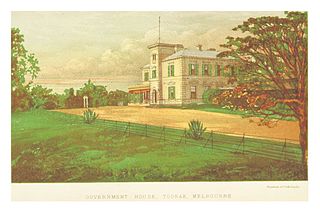
Toorak House is a mansion located in Melbourne, Australia built in 1849 by well-known Melbourne merchant James Jackson. It is notable for its use as Melbourne's first Government House and having inspired the name for the suburb of Toorak.
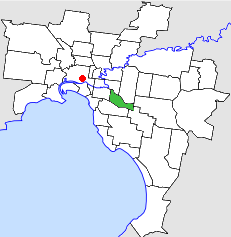
The City of Malvern was a local government area about 9 kilometres (6 mi) southeast of Melbourne, the state capital of Victoria, Australia. The city covered an area of 15.88 square kilometres (6.13 sq mi), and existed from 1856 until 1994, when it was merged with the City of Prahran to create the City of Stonnington.

The City of Prahran was a local government area about 5 kilometres (3 mi) southeast of Melbourne, the state capital of Victoria, Australia. The city covered an area of 9.55 square kilometres (3.69 sq mi), and existed from 1855 until 1994, when it was merged with the City of Malvern to create the City of Stonnington.
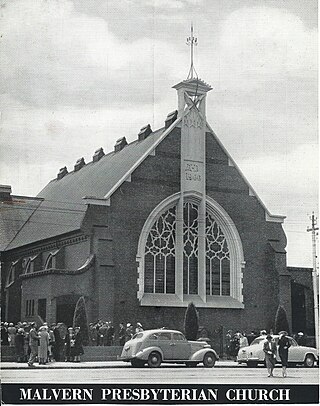
Malvern Presbyterian Church is located in Victoria, Australia. Opened in 1886, it was the first Presbyterian Church to be founded in the City of Malvern and is now within Stonnington, a metropolitan area of Melbourne.

John Munro Bruce was an Australian businessman. He was born in Ireland to Scottish parents and arrived in the colony of Victoria at the age of 18. He became the managing director and eventual majority shareholder in Paterson, Laing & Bruce, one of Melbourne's leading softgoods firms. He also held a number of civic positions, including as the founding club captain of the Royal Melbourne Golf Club. His son Stanley Bruce became prime minister of Australia.
William Sangster, the Scottish-born nurseryman and garden designer played a major role in the establishment of substantial public and private gardens in the period of the early development of Melbourne, Australia. He was instrumental in introducing the picturesque style of landscape design to Melbourne and its environs.
















